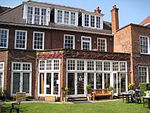NHS Gender Identity Development Service
NHS trustsNational Health Service (England)Transgender and medicineUse British English from April 2020

The NHS Gender Identity Development Service (GIDS) is a nationally operated health clinic specialising in working with children with gender identity issues, including gender dysphoria. Although based at a Tavistock and Portman NHS Foundation Trust site, it is commissioned by NHS England and takes referrals from across the United Kingdom. It is the only gender identity clinic for people under 18 in the UK and is the subject of much controversy.
Excerpt from the Wikipedia article NHS Gender Identity Development Service (License: CC BY-SA 3.0, Authors, Images).NHS Gender Identity Development Service
Belsize Lane, London Belsize Park (London Borough of Camden)
Geographical coordinates (GPS) Address Nearby Places Show on map
Geographical coordinates (GPS)
| Latitude | Longitude |
|---|---|
| N 51.5466 ° | E -0.1748 ° |
Address
The Tavistock Centre
Belsize Lane
NW3 5LA London, Belsize Park (London Borough of Camden)
England, United Kingdom
Open on Google Maps







